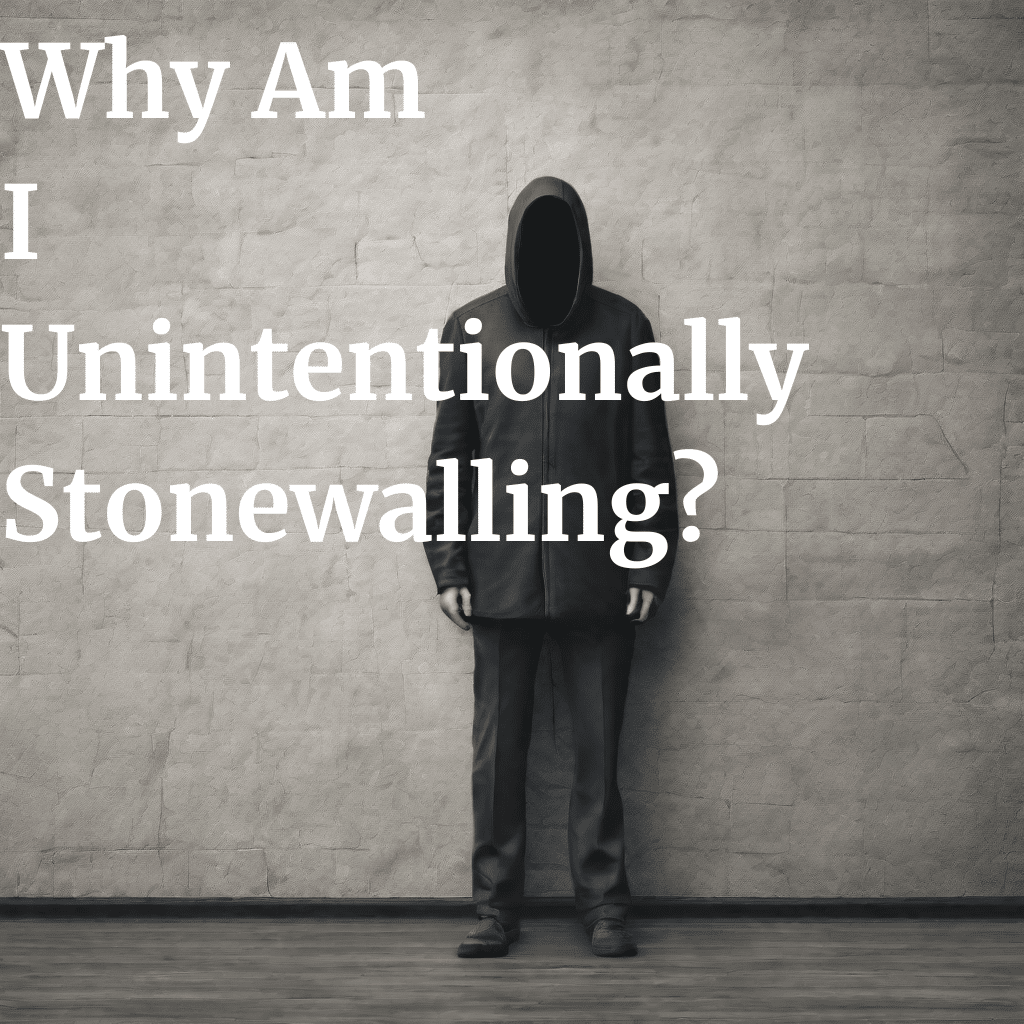Why Am I Unintentionally Stonewalling

While it’s easy to perceive stonewalling as a purposeful and calculated tactic, the perplexity lies in the realization that sometimes, it’s not a consciously chosen action. It begs the question – why am I unintentionally stonewalling?
Stonewalling is one of Goffman’s Four Horsemen. The roots of unintentional stonewalling are entwined firmly with the socio-cultural upbringing and the acquired behavioral patterns throughout our formative years.
As part of this society, we are often told that expressing feelings, especially those perceived as weakness, puts us in an unfavorable position.
For instance, men in our society are often subtly educated to suppress expressions of emotion, a norm that we’ve been accepting in silent compliance.
Our understanding and perception of our role models, particularly father figures, also play a significant role here.
For many, withholding information, avoiding communication, and stonewalling have been normalized through observation and thus, unknowingly pass on through generations. Interestingly, these beliefs and behaviors get so deeply embedded within our subconscious that we find ourselves resorting to them without any conscious realization.
Understanding Stonewalling
Detailed Explanation of Stonewalling
Stonewalling essentially involves creating barriers in communication, leading to a communication breakdown.
It typically manifests as avoiding communication, non-responsive behavior, and impenetrable defense which act as an obstruction tactic in cultivating meaningful and transparent dialogue.
Rooted in a defensive silence, stonewalling is more than just the act of imposing silence; it’s an emotional shutdown leading to a lack of transparency. This is not limited to verbal exchanges, but have implications for our emotional vitality as well.
Much like a physical stone wall, it serves a similar purpose in communication – it blocks, deflects, and ultimately stifles the exchange of thoughts, feelings, or information.
Many times, it is often misidentified as passive-aggressive behavior, since the outcome of creating barriers and withholding information can lead to feelings of frustration and powerlessness in the person on the receiving end.
Addressing the Unintentional Nature of Stonewalling
When we think of someone who stonewalls, we might assume that the person is intentionally refusing dialogue. However, this isn’t always the case.
For many, stonewalling can be an unintentional, automated response triggered by certain situations or conversations.
This is attributed to their upbringing, societal pressures, or simply the fear of conflict. They might not even realize that they have shut off, out into the void of emotional blocking.
Societal norms and expectations play a significant role here. Particularly in relation to masculinity, our society often valorizes strength and stoicism, causing people, specifically men, to equate emotional expression with weakness.
Consequently, behaviors such as avoiding important conversations or deflecting personal questions become the norm. The result – a defensive wall, not chosen but erected out of habit or pressure.
So, it is not always a conscious decision to refuse dialogue or withhold information. It can be an automatic reaction conditioned over time.
It’s a survival instinct, a learnt behavior that both protects the individuals and, unfortunately, reinforces the communication wall. Recognizing this habit is the first step to building emotional authenticity and healthier communication patterns.
The Impact on Relationships

An Analysis of How Stonewalling can Damage Relationships
Stonewalling, whether intentional or not, can significantly damage relationships. What starts as avoiding communication or imposing silence can slowly escalate towards an emotional shutdown, corroding the foundation of any relationship: open, honest, and transparent communication.
As information is withheld and barriers are created, dissatisfaction, resentment, and frustration can creep into relationship dynamics. The lack of transparency that stonewalling brings casts long shadows in the hues of unexpressed emotions and unsaid words, creating gaps in understanding and connection.
These gaps can lead to a profound communication breakdown, where individuals end up spiraling in a cycle of non-responsive behavior.
The emotional blocking that occurs during stonewalling can severely compromise the intimacy and trust in relationships.
Over time, it’s not uncommon for stonewalling to foster a sense of loneliness, alienation, and emotional disconnection, leading to the erosion of the relationship’s overall health, vigor, and vitality.
Exploring Common Scenarios Where Stonewalling Might Occur
Stonewalling is frequently observed in scenarios of high stress or serious discussions. In moments where feelings of anxiety, fear, inadequacy, or guilt are high, a person might resort to defensive silence as an obstruction tactic.
This can happen during conflicts, or even during what should be ordinary, significant discussions about finances, future plans, problem-solving, or addressing grievances.
In particular, individuals who have grown accustomed to automatically sealing off their emotions as a means of self-protection may revert to these learnt behaviors under high-pressure situations.
The challenge here is recognizing these scenarios for what they are and acknowledging the potential hurt they may cause before the communication wall solidifies. It’s important to understand that while stonewalling may provide temporary comfort from confrontation, it only perpetuates issues by refusing dialogue and avoiding resolution.
Steps Towards Change

Highlighting the Importance of Self-awareness in Recognizing Stonewalling Behavior
Change starts with awareness. Recognizing stonewalling behavior, particularly when it manifests as avoiding communication, defensive silence, or non-responsive behavior, is the first step towards transformation.
Relinquishing this impenetrable defense requires a level of self-awareness and introspection. Identifying moments where emotional shutdown kicks in out of habit or pressure is crucial in breaking the cycle of stonewalling.
This awareness can be built gradually by consistently observing one’s feelings and reactions during conflicts or intense discussions. It may be helpful to reflect on moments of communication breakdown or when silence was imposed instead of engaging in dialogue.
Recognizing these patterns can greatly enhance one’s ability to take down the built-up communication wall, paving way for deep, meaningful connections with oneself and others.
Providing Actionable Solutions and Alternative Ways to Express Emotions
Once awareness has been cultivated, the next step is adopting alternative ways of expressing emotions and engaging in discussions. Rather than obstructing dialogues and withholding information, it’s important to learn to articulate thoughts and emotions in a constructive manner.
This may involve rewriting internal narratives and challenging societal norms that promote emotional blocking as a viable response to stressful scenarios.
Alternative solutions can include assertive yet respectful communication, expressing emotions without hostility, active listening, and taking responsibility for one’s actions.
It’s beneficial to break the conversation into smaller parts, giving enough time to process and respond without feeling overwhelmed. Additionally, practicing empathy and patience can go a long way in dismantling the barriers and restoring the balance of power in relationships.
In summary, breaking away from the chains of stonewalling not only fosters healthier expression of emotions and robust communication but also strengthens relationships.
It’s a difficult journey, definitely, but the long-term benefits far outweigh the struggle. After all, it’s about transforming relationships, and more importantly, transforming ourselves for a richer emotional and relational landscape.
A Journey Towards Better Communication and Relationship Health
In this exploration of stonewalling, we dove into the depths of its definition, dissecting its origins, manifestations, and impacts along the way. Stonewalling, characterized by avoiding communication, imposing silence, and building up a defensive barrier, serves as an obstacle to open dialogue and intimate connections.
Rooted in societal norms and expectations, particularly those tied to masculinity and emotional expression, it often finds its way into our relationships, causing significant communication breakdowns and emotional disconnects.
We also acknowledged that stonewalling is often unintentional, a reflexive defensive mechanism prompted by anxiety, discomfort, or fear. It is a learned behavior that can significantly hamper our relationships – but it’s not irreversible.
Change is possible, and it begins with self-awareness. Recognizing stonewalling behaviors in oneself is the first step towards transforming these patterns.
The journey ahead entails challenging deep-seated norms and altering behaviors for healthier expression of emotions and robust communication.
This involves adopting alternative forms of communication, expressing emotions respectfully, listening actively, and taking responsibility for our actions. The idea is not just about breaking the cycle of stonewalling but moving towards creating stronger, more authentic relationships.
In conclusion, understanding the terrain of stonewalling and crafting productive strategies for change is an empowering journey towards better communication, stronger bonds, and emotional wellbeing.
By taking these steps, we not only improve our personal relationships but also grow and evolve as emotionally intelligent individuals.

